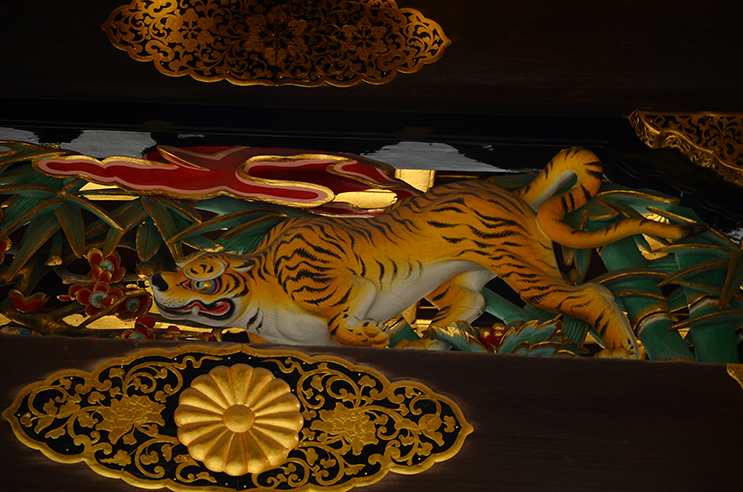The 400+ years old Nijo Castle was one of the sweetest surprises I found in Kyoto.
Usually I love to decipher places through signs and symbols, so my visit was a peaceful, yet exciting occasion to read the architecture and powerful imagery of this splendid historic site. More than an “enchanting castle”, Nijo-jo revealed itself gradually as a stylized representation of the Japanese spirit from the Early Edo Period.
Those passionate about heraldry and symbolism will find it hard not to spend a generous amount of time in front of the Karamon gate, in use since 1626. If you’re curious about its etymology, well, kara is a polysemantic word and means both “China” and “elegant”, and the term “mon”, beside its generic meaning of „gate”, is also a heraldic badge, a badge of identity. The general opinion is that “mons” evolved from different battlefield flags that illustrated the identity of military rulers.
Perhaps the most famous symbol on the gate is the Kiku-mon (present also on all Japanese passports), the national emblem and the Imperial Seal of Japan. This chrysanthemum, or kiku, with 16 petals is an old symbol of happiness and long life. Another symbolic representation easily observable on this gate is the peony. The red and white peonies usually refer to marriage, fertility and prosperity. Next to the peonies we can admire some blue butterflies. In Japanese tradition, butterflies are an ambivalent symbol. They refer both to short-lived happiness and to the soul of a dead person. But in this case we see two blue butterflies, and we understand instantly that the meaning is the positive one: a happy marriage.
Cranes are also present in this powerful picture. They are an old symbol of longevity, and military rulers of the past believed them to be divine messengers. We can also notice tigers, to express both bravery and warriorship. 400 hundred years ago, it was believed that leopards were female tigers, so you’ll see inside a painting of a tiger and a leopard drinking water together and feeling like a happy couple. The gate also includes a beautiful dragon, for protection and good fortune.
After the peaceful aesthetic emotion felt in front of this beautiful gate, I made my way towards the Ninomaru Palace, all set to discover even more beauty from the time of the Tokugawa Shogunate. It seems that, at the order of Tokugawa Ieyasu, many feudal lords gave money to build this palace that became the official Kyoto residence of Shogun Ieyasu. Its Early Edo architecture is elegant and simple, following the shoin-zukuri style that was favored by the warrior class.
Photography is strictly forbidden in the Palace, and the reason can be easily understood for this UNESCO World Heritage site. Works of art like the massive wall paintings made by prominent members of the Kano School need some serious preservation.
The palace has 33 rooms and over 800 tatami mats, and there are more than 3000 paintings inside, of which 954 were designated as Important Cultural Properties in 1982. I was also impressed by the Palace Corridor. Oh well, believe it or not, it chirps and it’s called the Nightingale Floor.
From the entrance (Yanagi-no-ma), you will visit the reception rooms (Wakamatsu-no-ma), the Retainers’ Waiting Rooms (Tozamurai-no-ma), the Formal Reception Room (Shikidai-no-ma), the First, Second, Third and Fourth Grand Rooms, the Inner Audience Chamber (Kuro-Shoin), the Ministers’ Offices (Roju-no-ma) and the Imperial Messenger’s Room (Chokushi-no-ma).
One of those Grand Rooms, the Ohiroma Ichi-no-ma had a great importance in Japanese history, because that was the room where almost 270 years of Tokugawa military rule came to an end, after the 15th Tokugawa Shogun Yoshinobu declared that sovereignty should be restored to the Emperor. That happened in October 1867.
The Palace Garden, or Ninomaru Garden is said to have been created initially by the great master garden designer Kobori Enshu. It has been changed a few times and in 1953 was designated as a Special Place of Scenic Beauty.
The garden includes one large island, representing Horai-jima, the Island of Eternal Happiness), flanked by 2 small islands (representing Tsuru-jima/ Crane Island and Kame-jima/ Turtle Island).
The next stop, Honmaru Palace is closed unfortunately. It was added to the castle complex in 1626 and faced many unfortunate events. The original construction included a five-story castle tower that was struck by lightning and burned down in 1750, rebuilt and, later, in 1788, destroyed again in a great fire. The present structure was built in 1847.
The final stop was the Seiryu-en Garden, a not so old addition to this complex, built in 1965. The two tea houses (Koun-tei and Waranku-an) used for receptions and the stones came from the residence of a Japanese wealthy merchant.
After a relaxing walk around, I left this delicate castle thinking of the surprisingly sublime taste that military rulers of Japan had more than 400 years ago.
Photos by Alexandru Mihai Gheorghe

Monica works as a writer and translator, and is a passionate researcher of pop-culture, anthropology and cinema. In her spare time she also enjoys toy photography and often searches for old Japanese art toys to enlarge her collection. She also loves to discover monsters from old movies, folk tales, myths and legends of various cultures.

















